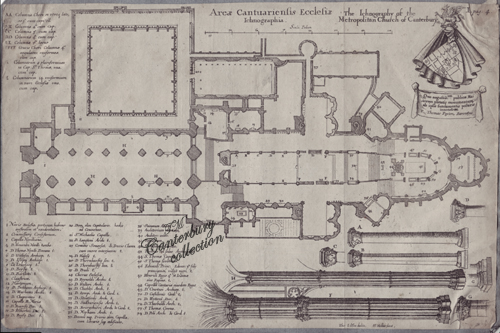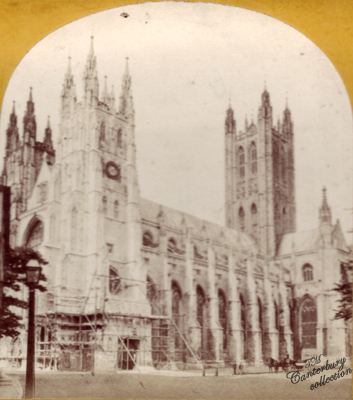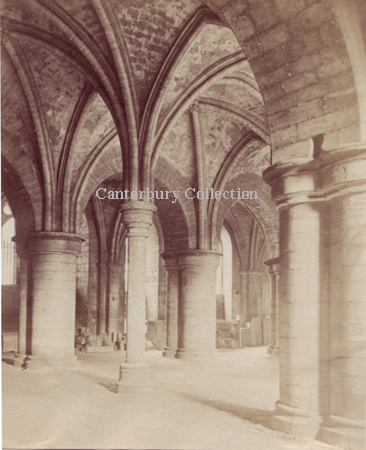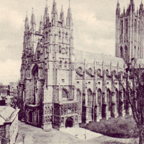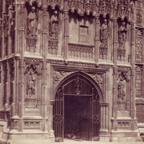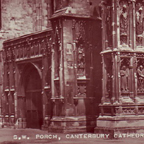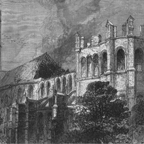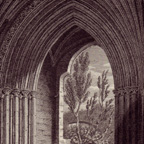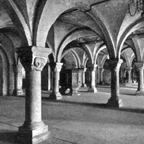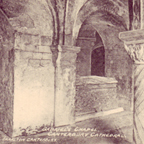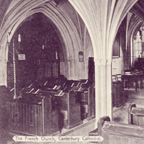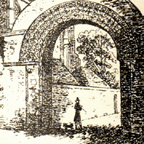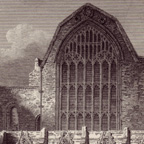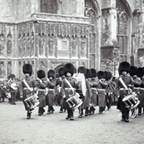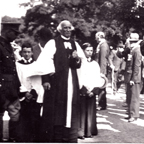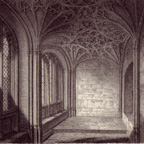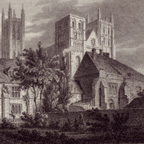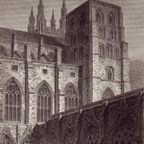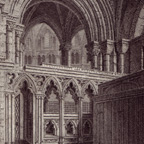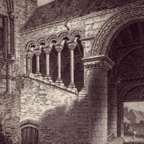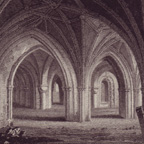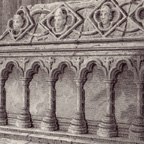~ CANTERBURY CATHEDRAL ~
CANTERBURY, KENT
A "Clickable" Map of Canterbury Cathedral & Grounds
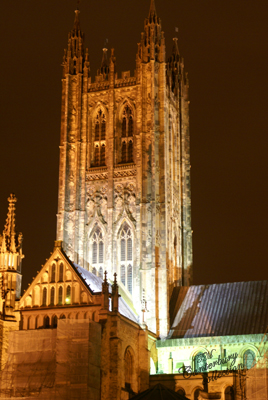
The Cathedral January 2011
1170, was the Martyrdom of Archbishop Thomas Becket in the Cathedral. In 1538 the Shrine of St. Thomas was destroyed and all the treasure confiscated by King Henry VIII.
"Hence started the Kentish rebels under Wat Tyler on their march to London in 1381, taking with them as prisoner Archbishop Sudbury, whom they beheaded later on Tower Hill, in this point curiously repeating the action of the Danes during their invasion of 1011, who seized Archbishop Elphege from this cathedral, and shortly afterwards put him to death at Blackheath."
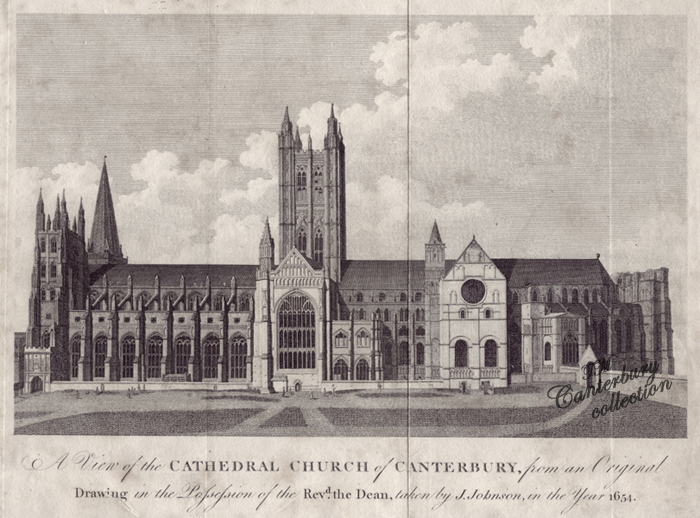
"A view of the Cathedral-Church of Canterbury in Kent" J. Johnson 1654
Area Cantuariensis Ecclesia Ichnographia, dedicated to Thomas Peyton, Baronetus with his crest above (I believe this is from Monasticon Anglicanum 1718)
*Sir Thomas PEYTON who m. in 1732 Miss SKEVINGTON. June 29th, 1771 when the Baronetcy expired.
(A Portrait of Sir Thomas Peyton, Bart., by Mireveldt, 7l, was sold by auction at Canterbury on the 4th inst. 1870)
Charles I. was married to Henrietta Maria here in 1625.
1641 - Canterbury Cathedral attacked by the people, who plundered it of its ornaments and brasses.
The "Canterbury Christmas," that
of 1647, is known for the resistance offered here to the attempt to
carry out the decree of Parliament against the observance of the day.
Out of the rising that ensued grew the "Kentish Petition"
for the release of Charles I., supported in the following summer, by
an armed gathering of the gentry and yeomanry of the county, which was
scattered by General Fairfax in the battle of Maidstone.
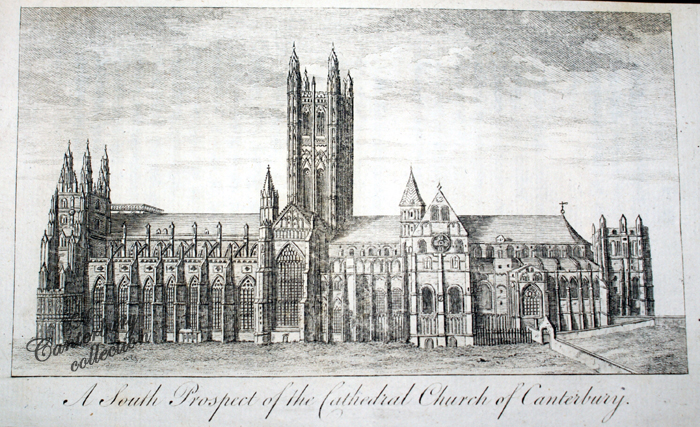
"A view of the Cathedral from "A Walk in and about the City of Canterbury" my William Gostling edition 1777"
...Besides other children, he left a son Edward, collated by archbishop Wake, in 1721, to the sixth prebend in Canterbury cathedral, in which stall, on his death in 1732, he was succeeded by his son Edward, who was also rector of Monks Risborough in Bucks. Mr. Edward Wake, the grandson, died in November 1738, and was interred in Canterbury cathedral." GM
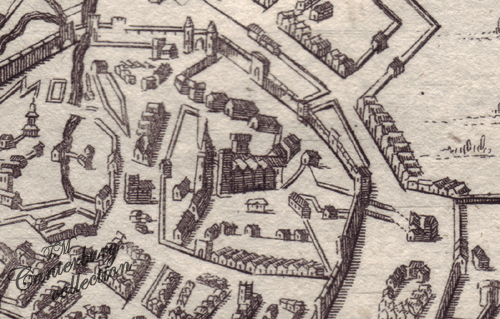
"A detail of the Cathedral from one of my old maps"
"A monument to his memory, with his effigy kneeling, is in St. Michael's chapel, erected by his surviving son, Searles Prude; on which we are told, that he "married Mary, daughter of Sir Adam Spracklin, knt. and had four sons and three daughters." There are also some verses, expressive of his piety as well as valour. The Gentlemen's Magazine - the following Memoirs of Lieut. Colonel William Proud, who was slain at the siege of Maestricht, July 12, 1632, extracted from a scarce sermon (on 2. Sam. III. 38.) preached at his Funeral in Canterbury Cathedral, Sept. 20, by Francis Rogers, D.D. Minister of St. Margaret's in that city, seem worth preserving. Page 349-350
"Sacred to the memory of William Prude, Esq., Lieutenant Colonel in the Belgic Warres, slayne at the seige of Maxtrich, the 12th July, 1632. He married Mary, daughter of Sir Adam Spracklin, Knt., and had issue by her, four sons and three daughters. To whose memory his surviving sonne Searles Prude, hath erected this monument."
On the card...The clock dates from 1386 and is probably the oldest clock in England. It was in the detached Bell Tower until 1790 when it was removed to the Central Tower of the Cathedral and kept going until 1884 when a new clock was installed. In April 1931 it was placed in the North Transept." a card in my collection.
1173 - Christ-Church in Canterbury was Burnt. - A chronological history of England 1714
"The Cathedral with scaffolding on the porch"
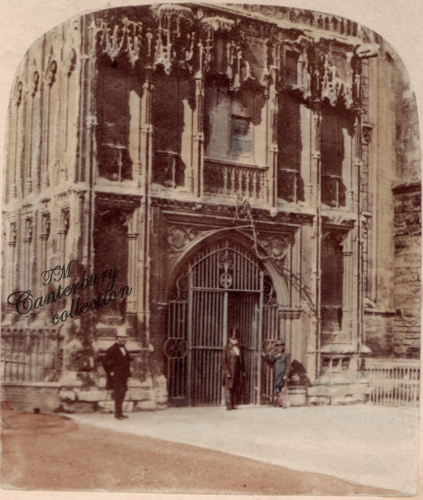 __
__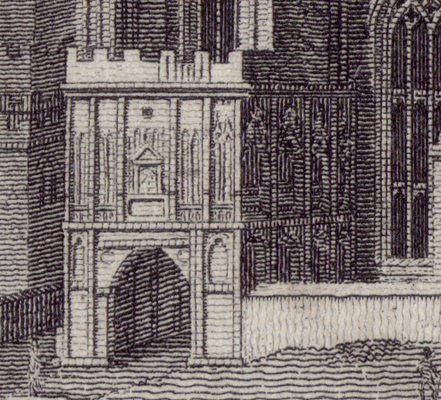
A view of the South-West Porch c. 1860's before the statues were restored (and 1654 detail on the right)
these were removed or damaged during the Reformation

Feb 27, 1869 - Historical Figures in Canterbury Cathedral. The south-west porch and the whole of the west end of the Cathedral are now filled with niches for statues; and within the last month those of Queen Victoria and the late Prince Consort have been erected. A movement was set on foot by the Dean in 1862 to fill the niches with historical figures connected with the Cathedral, and thirty-six are now in their places, including Gregory the Great, Archbishops Theodore, Dunstan, Alphage, Becket, Baldwin, Hubert, Walter, Langton, Courtenay, Sancroft, and Laud; Kings Alfred, Edmund, Canute, Edward the Confessor, William the Conqueror, William II., Henry I, Henry II., Edward III. Henry VIII., Edward VI., Charles I. the Black Prince, Bishop Ridley, and Dean Stanhope. The work was undertaken by Mr. Pfyffers the scupltor at a cost of 24l. each. The southern face of the porch has beem reserved for the four archbishops who have had the most influence on the Church, viz. Augustine, Lanfranc, Anselm and Cranmer. These have been placed above, and King Ethelbert and Queen Bertha below. TA (*Theodore Pfyffers, a Belgian Sculptor)
"In six years 31 statues had been erected; another effort was made, and before the winter of 1870 nearly all the niches were filled, and this portion of the outside of the cathedral was probably in a more complete state than it had ever been previously."
....It may not be known to some here that a great work is being done at Canterbury. I have not been able lately to visit that most interesting cathedral, but a friend has sent me particulars of what is being done there. Many of the vacant niches have been filled with figures, where these had never before been placed, or, if placed had been destroyed. The south face of the porch and the east side of it have already been supplied with historical figures, and it is intended to carry on this work till the original design is perfected. Now to accomplish such a work, the study of the Wells figures is invaluable.....
The Builder, April 30, 1870
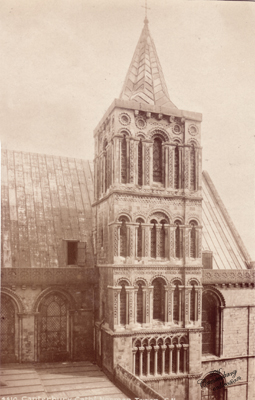
The Norman Tower
The pulpit posted October 5, 1907 posted from Watford to Miss Pownall, Crofton Road, Heaton, Bradford, Yorks from my collection
"The image is reversed, the pulpit steps are to the left not the right. Also note that the chairs in the image are facing to the left as the pulpit is on the north side the altar is on the East so anyone seated on them would have their backs to the altar. Maybe it was an error when the photographer printed the film." Thanks so much to Tricia for spotting this!
Warham Memorial from my collection
"Henry Arundell, Clerk. Syr Henry Arundell, one of the Prestes of the Almery in Christ Church. My body to be buried in the church-yard of Christ Church. Syr Humphry Garth, parson of St. Mildred in Canterbury. Proved at Canterbury 29th Oct. 1540" TV1826
A view of the Cathedral showing the area where the fire was (on the left)
A view of the "Table Hall", Canterbury Cathedral grounds, posted from Canterbury Sept 10th 1915 - to Miss Bessie Surgenor.14 Halstead Rd. Seacombe, Cheshire. Friday. Another card I don't think I have sent before. Have been out all day putting water on some haystacks which were on fire. I was collared going to post letter this morning. Jim.
Banns - June 26th, July 3rd & July 10th, 1825 - James TERRY of St. Alphage, Canterbury to marry Martha BAINES of the Precincts.
Marriage - July 12th, 1825, James TERRY of St. Alphage married Martha BAYNES.
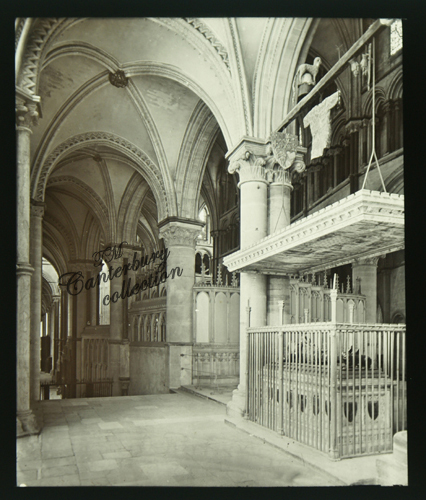 __
__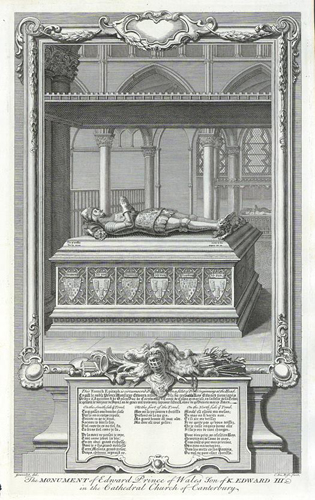
The Black Prince and his tomb in the Cathedral (a Magic Lantern Slide in my Collection)
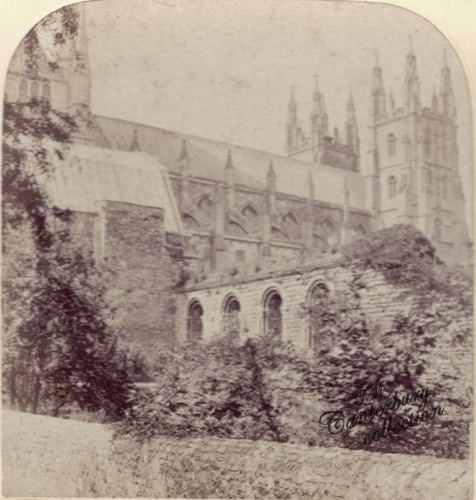
Western Towers and Arches, Canterbury Cathedral c. 1860's
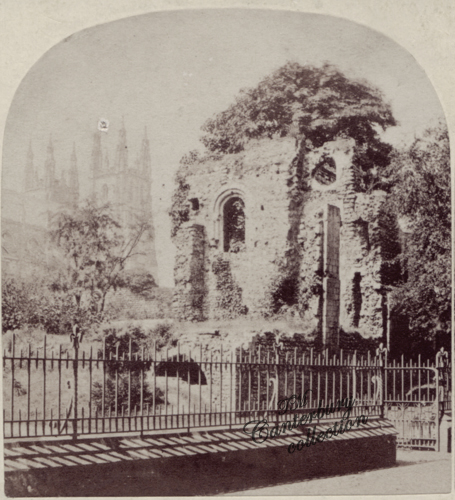 __
__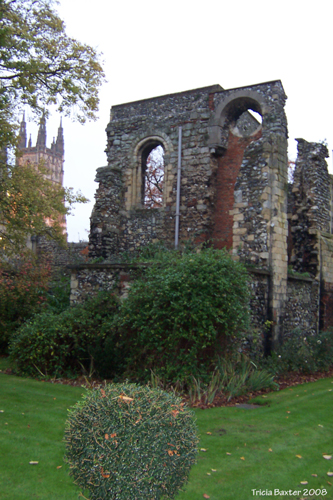
Western Towers and Ruins, Canterbury Cathedral c. 1860's & Now (West wall of the Necessarium)
"The Library, erected on the site of the prior's chapel, with the original ambulatory beneath, contains some valuable books and manuscripts, the manuscripts of Isaac Casaubon, William Somner the antiquary and others, a collection of Greek and Roman coins and an extensive collection of Bibles. A handsome and extensive building in the Norman style erected in 1868 on the north side of the Chapter House, for the reception of the library, was opened on the occasion of the enthronement of the present Archbishop, on February 4th, 1869; and is open for reference for two hours on Tuesday and Saturday each week." 1882
Green court gate prior to the demolition of the buildings on the left
"In the fifteenth century a new library was built by Archbishop Chicheley, over the prior's chapel. That building occupied the same site as the room which now contains the Howley Harrison collection of books, and the library above it therefore filled the same space. Access to the library was obtained by means of a narrow staircase in a gallery outside the passage leading from the lavatory tower to the transept of the church."
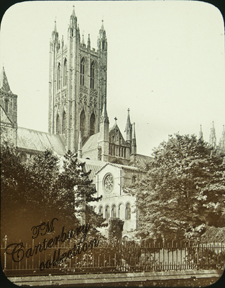
A view of the library from a Magic Lantern Slide in my collection
THE OLD LIBRARY
This library suffered severely from fire in former ages, and was deprived of some of its treasures during the Cromwellian usurpation: it therefore does not possess many volumes remarkable for their antiquity; but, we are told, it is matter of great congratulations to the Dean and Chapter that so many valuable MSS relating to Saxon literature in general, and the count of Kent in particular, should be contained within their walls. Whoever wishes rightly to estimate the labours of the indefatigable Somner, should examine this collection, where will be found two copies of his excellent Dictionarium Saxonico-Latinum, from one of which it appears his work was printed in 1659. The title, recommendatory verses, dedication, preface, list of subscribers, and errata, are here preserved. Here also is his M.S. Treatise of the Roman Ports, &c. printed in 1693. Other works of this eminent antiquarian scholar are mentioned, and MS. notes by him in various books in the library. Also his "Miscellanies;" consisting chiefly of letters relating to the affairs of the cathedral and the diocese of Canterbury; containing curious remarks on the characters, residences, &c. of many incumbents in the diocese. Further instances of Somner's industry and learning will be found in pp. 10, 11, and 12, of Mr. Botfield's work, as Orosius, Saxonice, a transcript from a very ancient MS. in the Cotton Library; and Caedmon's Saxon Paraphrase, from a MS. in Bibl. Deuvesiana.
A MS. is here preserved of the Register of St. Austin's Monastery, which is believed to be the last, the establishment having been dissolved 30 Henry VIII. Some few of the MS. volumes belonging to this monastic library have been preserved in the cathedral, of which a list is given, p. 13. A list of the books formerly in this library is given by Dart, in the Appendix to his History of the Church of Canterbury.
Isaaci Casauboni Ephemerides, folio, or the Diary of Isaac Casaubon, who came over to England in the time of James the First, and was made prebendary of this church. This MS. was written in his own hand, commencing in the 39th year of his age, in 1597; he died in 1614. From a passage in this Diary we learn that Casaubon, being a layman, received the royal dispensation to hold this prebend. It is said that Bentley was indulged with the use of this interesting volume; but why is it not printed at the expense of the wealthy Chapter?
A beautiful MS. of Ciceronis Epistolae, folio. At the beginning is this MS. note: "This booke I Edmund Witherpoll found in the Lybrary off owre Ladyes Churche in Bulleyn the xxv day of Sept. Anno Domini 1544." Edmund Witherpoll it is said probably accompanied Henry VIII. in his expedition against Boulogne, and brought this MS. away with him.
In English poetry there is the Stimulus Conscientiae, or Pricke of Conscience, by Richard Hampole (called the Hermit of Hampole) who died in 1349, 4to. However on this subject Warton's History of English Poetry should be consulted, vol. ii. p. 90 to p. 99, 8vo., with the learned note of the Editor, and Ritson's Bibliographia Poetica.
There is also a volume of English Poetry in 4to., entitled "Epigramma Satiron; or, The times whistle, or a newe daunce of seven Satires, whereunto are aunexed divers other poems comprising things naturall, morall, and theologicall, compiled by ----------- gent."
"Septem compacta cicutis
"Fistula."
The name of the compiler is in this first title erased. He announces the design of those seven Satires in a long Introduction.
To these Satires are added "Certain Poems, comprising things naturall, morall, and theological. Written by R.C. gent." These satires, from various allusions in them to Marston's Scourge of Villanie, 1598, appear to have been written near that period. They appear to have been intended for the press, but Mr. Botfield observes, "They might have been suppressed in consequence of the order towards the close of Queen Elizabeth's reign, signed by the Archbishop of Canterbury and the Bishop of London, that Marston's Pigmalion's Image, and Certain Satyres, Hall's Satires, Sarlinge Satires, &c. should be burnt, and that "no satyres or epigrams be printed hereafter."*
The Psalms translated into English metre by Archbishop Parker, finished in 1557, and soon after printed. The book is extremely scarce. Strype says he could never see one. In Bright's sale in 1805 it fetched forty pounds ten shillings!! Warton thought that the work was never published, but that the Archbishop permitted his wife to present the book to some of the nobility. See his History of English Poetry, vol. iv. p. 5, where is some curious information on the subject. He says "In the late Mr. West's library there is a superb copy, once belonging to the Bishop Kennet, who has remarked in a blank page "that the archbishop permitted his wife Dame Margaret to present the book to some of the nobility." A Dr. Lort, when chaplain to the Archbishop of Canterbury, found in the library a beautiful copy of the Psalms, on the back of the title of which was written. "To the right virtuose and honourable Ladye the Countess of Shrewsburye, from your lovinge frende Margaret Parker."**
These we think are the chief curiosities in
the library of this cathedral. There was a Dr. John Bargrave, a canon,
who was a great benefactor to the library. He was a great traveller,
and lived chiefly in Italy during Cromwell's usurpation. "On the
margins and backs of the engravings he has written many curious remarks
from printed books and manuscripts, and has added several pleasant and
interesting anecdotes, the fruits of his own observation. On the margin
of the Pope's picture in the volume Alexandri VII. Papae, et Cardinalium
Effigies per Joan.Jacob. de Rubeis. Romae, 1658, folio, he has written,
"This picture and all the rest following are extraordinarily like
the persons, drawn and cut by excellent hands; I knowing them all by
sight (and some by discourse) as well as I knowe any of my brethren
the canons of Chr. Church, Canterbury." Dr. Bargrave's cabinet
of antiquities and curiosities is perserved in the library with due
care."
1849 Botfield's Notes on Cathedral Libraries in England
*The reader may consult Ritson's Bibliographica Poetica, p. 150 under R.C. - Rev.
**Mr. Park's note, p. 11, to Warton's text, should be read and considered on the subject of this version, over which some doubt still seems to hang. - Rev. (Gent. Mag. Vol. XXXII)
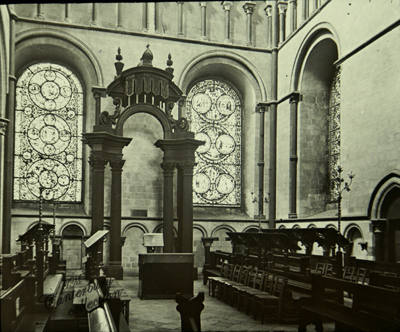
A view of the The Lady Chapel from a Magic Lantern Slide in my collection
"May 18, 1824 - The system of meddling in our ancient architecture is now become so prevalent, that when I some time ago heard that extensive improvements were carrying on in Canterbury Cathedral, I shuddered lest the common, though not very correct interpretation of that term should, in the present instance, be applicable to Canterbury, as at a former period it was to Salisbury, and in very recent times to Winchester Cathedral. But improvements are really necessary in Canterbury Cathedral - improvements of a far more extensive, if not more important kind than those which I shall presently examine; and I hope that ere the skilful hand which is now employed reposes from its labours, some portion at least of the execrable wood work which lines the choir and the high altar, and which consequently shuts out all the fine monuments from that part of the Church to which they more properly belong than to the side aisles, will be removed. This might the more easily be done, as no substitute would be wanted: the monuments answer the purpose of screens, which would otherwise be necessary, and a more splendid display of sepulchral architecture cannot well be imagined than is now concealed from public view by a mean fence that would be useful in the form of pews in a parish Church.
The detestable fashion of whitewashing the whole inside surface of Churches, was practiced in Canterbury Cathedral. Painted walls, purbeck pillars, and gilt crosses, were promiscuously covered with this substance, which was so often and so liberally repeated, that its removal constituted the chief part of the trouble; the result, however, of much indefatigable labour, and of a considerable expense, has been the restoration of the choir to its original beauty. The mouldings and carvings of the bosses, ribs, arches, and capitals, have all the freshness of new sculpture, and present an elegance of form, and a delicacy of workmanship, which they were scarcely known to have possessed. The main pillars of all the arches are of stone, and the slender attached shafts of purbeck marble, which afford a contrast in general highly pleasing, but in this instance rather unharmonious, owing to their blackness. It is to be regretted that this defect had not been avoided; no other is to be discovered in the renovated choir of Canterbury Cathedral; but this detracts nothing from the commendation due to the Honourable and Reverend Archdeacon Percy, whose personal attention to the work, during its progress, was unceasing, and whose anxiety to restore, as much as possible, the pristine beauty of the architecture, is worthy of imitation and admiration.
....With equal propriety and effect ornaments of wood were added to fabrics of stone; as for example, in the monuments of the Confessor's Chapel, and, among many others, in the tombs of Edward the Black Prince, and King Henry IV. in Canterbury Cathedral. In all these instances, the canopies are perfectly independent of the tombs to which they belong; and in those of Westminster Abbey in particular, these elegant appendages are crooked and broken from age and neglect, notwithstanding which, however, it is to be hoped that they will not, like the iron screens and ornaments, be deemed unnecessary and unsightly, and consequently be removed...." GM 1824
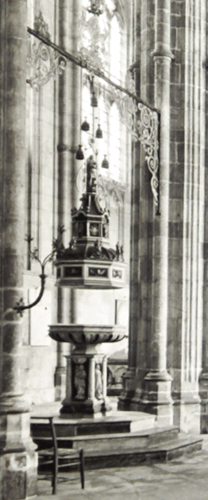
"The Font", a detail from a Magic Lantern Slide in my collection
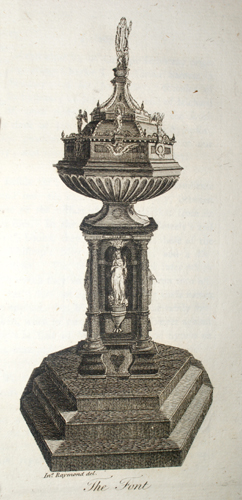
"July 21, 1828 - Death of the Archbishop of Canterbury, at Lambeth Place, aged 73, his Grace the Most Reverend and Right Honourable Charles Manners Sutton, D.D. Lord Archbishop of Canterbury, Primate of all England, and Metropolitan, a Privy-Councillor and Lord of Trade and Plantations, Official Visitor of All Souls and Merton Colleges, Oxford, and of King's College, London, Governor of the Charter-house, President of the Corporation of the Sons of the Clergy, of the Society for the Propagation of Knowledge in Foreign Parts, of the National Society for Education, and of the Naval and Military Bible Society.
His Grace was born February 14, 1755, the fourth son of Lord George Manners Sutton (third son of John third Duke of Rutland, K.G.) by Diana, daughter of Thomas Chaplin, of Blankney, in Linconshire, esq. He received his education with his brother Lord Manners, at the Charter-house, and thence removed to Emanuel College, Cambridge. In 1777, on taking the degree of B.A. he was the fifteenth Wrangle (his brother Lord Manners, who was with him at Emanuel also, at the same time being fifth Wrangler); he proceeded M.A. 1780, D.D. 1792. In 1785 he succeeded Richard Sutton, D.D. in the Rectory of Averham with Kelham (at which place is the family seat of the Suttons) in Nottinghamshire, and in that of Whitwell in Derbyshire; his brother being the patron of the former, and the Duke of Rutland of the latter. In 1791, on the death of Dr. Tarrant, he was appointed Dean of Peterborough; and in the following year, on the decease of Bishop Horne, he was elevated to the see of Norwich, then resigning all his other preferments. etc. etc. page 173" GM1828
The Death of his widow Mary nee Thoroton, aged 76 in Gloucester-pl. March 10, 1832 (Married April 3, 1778)
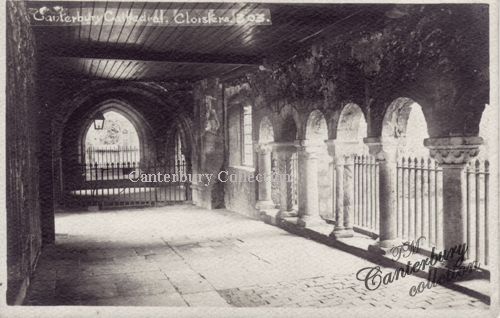
The Cloisters from an old postcard in my collection
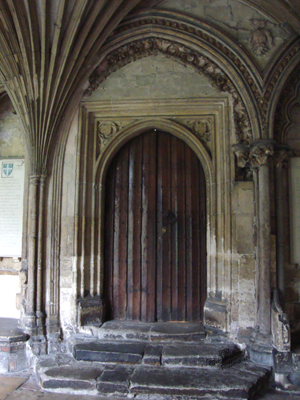
Great Cloister looking towards the door to the North West Transept
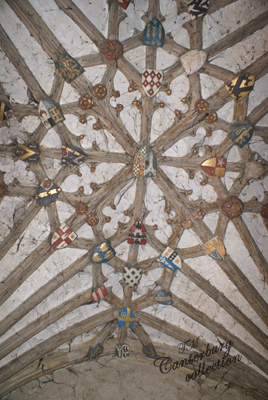
The Ceiling of the Great Cloister, Canterbury Cathedral
Chapter House 2010
"The north-western tower, which was, perhaps among the oldest portions of the cathedral, has been lately taken down, in consequence of its dilapidated state. The foundation-stone of a new tower, to be raised in its place, was laid in September last; and the Dean and Chapter were empowered last year, by Act of Parliament, to borrow 25,000l., for the cost of its erection." The Saturday Magazine March 16, 1833
A view of the Cathedral after the bombing
The Annual Register - 1839
Marriage August 26, 1839
At Canterbury Cathedral, by his grace the archbishop, major Hutchinson,
eldest son of Lieut.-General sir W. Hutchinson, K.C.H., to Mary, daughter
of the Rev. Dr. Russell, prebendary of Canterbury and rector of St.
Boltolph's
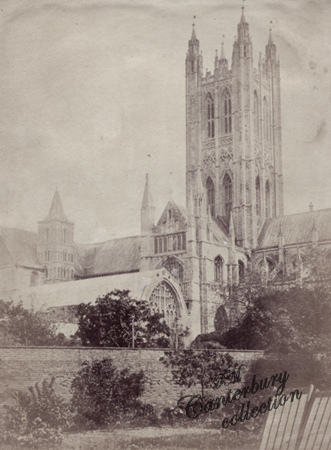
A photograph of the Cathedral from my collection (a view from the north-west)
"In opening a passage from the deanery garden to the dark entry, in the Canterbury precincts, and which has long been closed, a handsome stone archway was discovered, which had been plastered over to correspond with the wall of the entry. It is of very elegant proportions and beautifully sculptured. It is now fitted with a new oaken door, and forms a convenient communication from the deanery to the Cathedral." GM1847
___
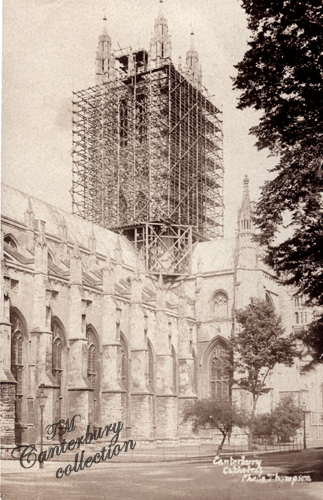
Ecclesiastical Preferments - Rev. T. Hirst, Minor Canonry, Canterbury, Cathedral. Rev. H. L. Jenner, Minor Canonry, Canterbury, Cathedral. AR 1852
"died July 1, In the Precincts, Canterbury, aged 48, the Rev. Frederick Vernon Lockwood, Canon of Canterbury and Vicar of Minster, in Thanet, formerly chaplain to the House of Commons, and in acknowledgment of that service nominated by the Queen to a prebendal stall at Canterbury, in 1838. He married, July 21, 1840, his cousin Mary Isabella, eldest surviving daughter of the Hon. Hugh Percy, D.D. Lord Bishop of Carlisle, and grand-daughter of the Most Rev. Charles Manners Sutton D.D., Archbishop of Canterbury." AR1852
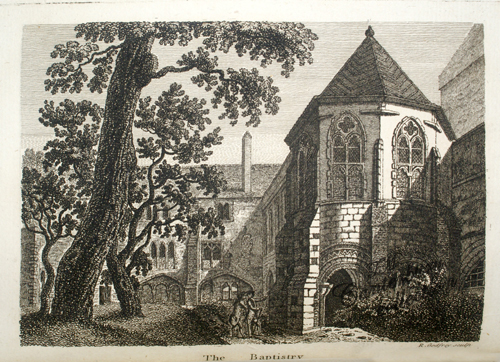
The Baptistry from William Gostling's "A Walk in and about Canterbury," the 1777 edition
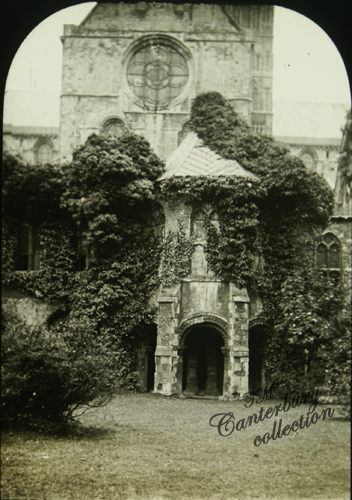 _
_
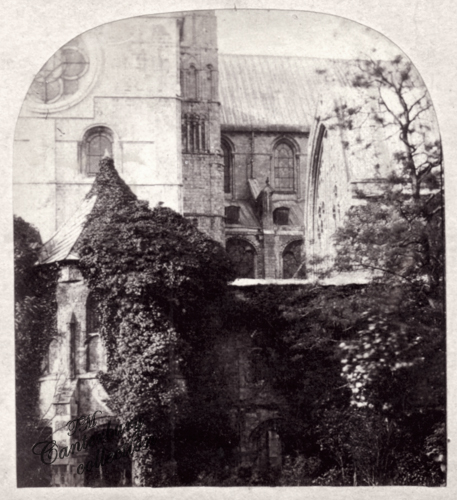 \
\
The Baptistry, a Magic Lantern Slide, and an old stereoview in my collection
"In the report of the Commissioners on the Cathedral and Collegiate Churches, it is stated that at Canterbury the northwest, or Lanfranc's Tower, was rebuilt at a cost of £25,000; and a gradual restoration of the whole fabric, exterior and interior has been in progress from 1823 to the present time. The whole amount expended in 30 years is stated at nearly £100,000 the whole arising from capitular funds." GM 1854
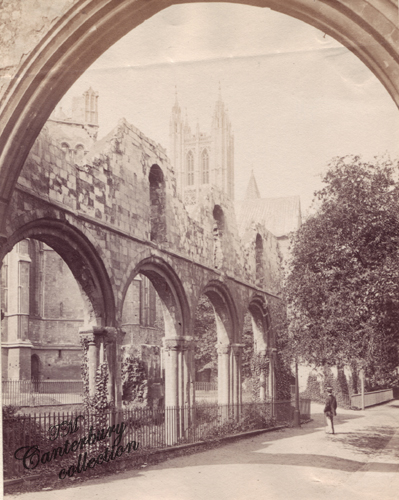
Ruins of the hall of the Infirmary, where the sick Monks used to reside

The Infirmary, the remains of which had been so well opened out, was used for the reception of sick monks. AJ 1875
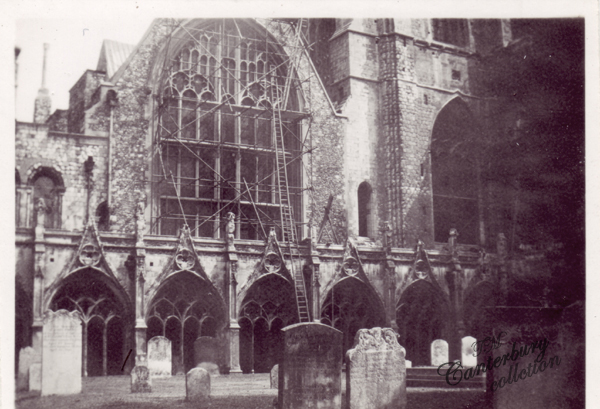
The Cloisters, photographs from my collection
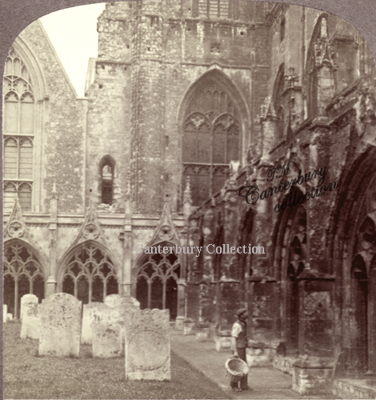
THE CLOISTERS - BURIAL GROUND
__
"A memorial window has been placed in Canterbury Cathedral inscribed with the name of its late architect, Mr. George Austin. It is seen on entering the church by the south porch; and forms the commencement of an intended design to restore the series of subjects which formerly filled the windows on the north side of the nave, viz. representations of the Royal line of England. It contains the figures of six Kings, Ethelbert the founder of the church, Ercombert, Egbert, Ethelwolf, Alfred the Great, Canute, Edward the Confessor, and Harold. The style of the glass is that of the latter end of the 15th century; and it has been manufactured in Canterbury." GM1855
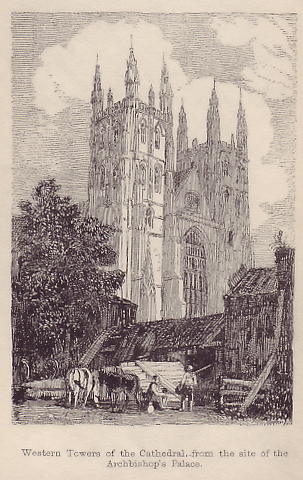
A drawing of Canterbury Cathedral with the Tower rebuilt and the Archbishops Palace in the foreground.
Sept 3, 1832 - The ceremony of laying the first stone of the new tower of Canterbury Cathedral took place; which tower, when finished, will render the cathedral the first in point of beauty, as it is in point of precedence in the kingdom. The Gentlemen's Magazine Vo. 152
"In this neighbourhood, and especially in the carpenter's yard aforesaid, are the best views of the western front of the Cathedral, and of Mr. Austin's tower (see frontispiece). (The erection of this structure was a work of great difficulty, and only consummated by great skill and perseverance on the part of Mr. Austin. After separating the nave walls from the falling tower, he raised the crippled groinings and strained the walls into their upright condition, fixing them there until the new tower could be erected. The old Norman Tower was then taken down and its substitute erected in exact uniformity with its sister tower.) According to our creed on the matter of restorations, we should have preferred that the old Norman tower had been replaced entirely, but this was impracticable, as it was necessary to support the centre window, then in a tottering condition, and so it was decided to have a companion tower to that at the south angle. It is a work which, considering the very great difficulty of producing an harmonious union of new with old work, reflects the highest credit on the architect. And when it is known that this tower stands on what is little better than a bog; that since its erection it has not started or sunk a single inch, and that no accident whatever happened in its construction, we think it may be called justly a work of first-rate ingenuity. In digging the foundations of this tower, which are formed by piles, the workmen came to the skeletons of a man and two bullocks, all in an upright position. How came they there? How came they in that upright position? Was the man a cattle-driver swamped in a bog? How long since? Let those resolve these points are able. Before I desist from examining the exterior of the Cathedral in connexion with the surrounding buildings, I would endeavour to correct what I believe is a popular fallacy on the subject, and one which, from time to time, is seriously detrimental to the best interest's of the picturesque. It is my conviction, that lofty Gothic buildings are best seen in contrast with others of very inferior height and size. People regret that no one view takes in the whole of Canterbury Cathedral, and artists exaggerate in order to squeeze it into one point of view. This seems to me to be altogether a mistake. Mr. Britton, too, says, "Canterbury Cathedral is placed in a flat level part of the country, and has therefore no picturesque advantages from situation." Again, "The north and east end are mostly bounded by private gardens, obscured by houses, and shut out from public approach by walled enclosures." (Since the above was written many of the buildings thus complained of as unsightly and out of place, have been removed.) "We cannot help regretting this circumstance, for the present fabric, as well as all the great churches of the country, should be placed in open areas, not only for the purpose of being minutely and fully examined by the curious stranger, but to protect their walls and foundations from injury." This is said without due reflection upon the principles which always influenced the erection of Gothic buildings, and greatly would the effect be lost if the area were opened as desiderated by Mr. Britton." FS 1843
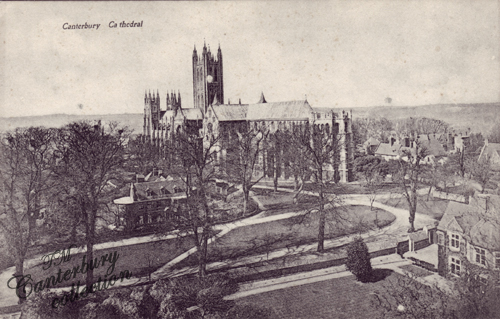
Marriage of November 19th, 1844 at the Cathedral, Canterbury, William Gardner, esq. of Beaksbourn, to Jane-Angelica, second dau. of George Austin, esq. of the Precincts, architect. GM 1845
Marriage August 31 at the Cathedral, Canterbury, S. Musgrave Hilton, esq. of Brambling House, Kent, to Emily Shuttleworth, eldest daughter of the Rev. William Stone, Canon of Canterbury. GM 1864
Marriage October 7th at Canterbury Cathedral, Julian third son of the late John Marshall, esq., of Headingley House, Leeds to Florence Ashton, eldest daughter of the Rev. John Thomas, Canon of Canterbury. GM 1864
Marriage February 2, At Canterbury Cathedral, Edward Yewd Brabant, esq., Lieut. Cape Mounted Riflemen, to Mary Burnet, eldest daughter of the Rev. J. C. Robertson, M.A., Canon of Canterbury. GM1865
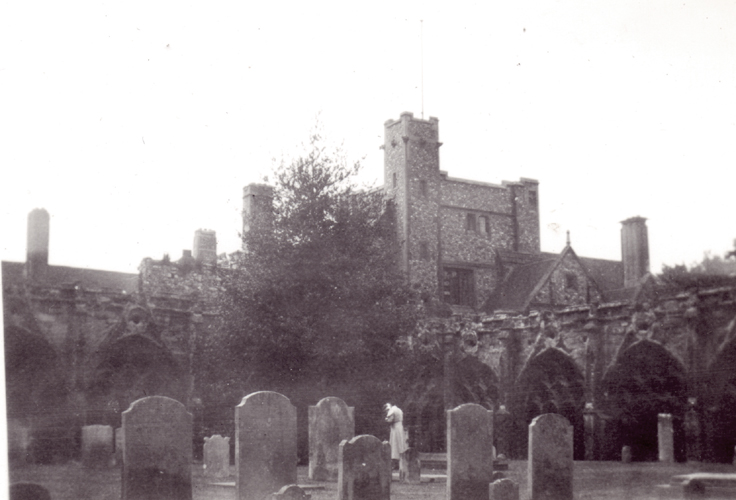
"The grand central tower, completed by Prior Selling in 1472, was originally called the Angel Steeple, from its being once surmounted by a pinnacle bearing a gilt angel, but is now more familiarly known as Bell Harry Tower, from "Bell Harry," a small bell given by Henry VIII. and placed on its summit under a penthouse: it is rung, each time for ten minutes, every morning at a quarter to 6 in the summer, and quarter to seven in the winter half of the year (this custom being the only existing remnant of an early service formerly held in the Sermon House or Chapter House), before morning and afternoon daily service in the choir and as a curfew at 8 pm; it is never tolled but on the death of an Archbishop of Canterbury, or of a member of the Royal Family." 1882
An old photograph in my collection, under Beckets tomb
"The Treasury contains the ancient charters, a number of them Saxon and some prior to the Norman accession, one being a charter by King Ethelbert, written by St. Dunstan."
The north-west or Arundel Tower was originally built by Lanfranc, whose work remained until 1834, when the tower, having fallen into a dilapidated condition, was rebuilt by the Dean and Chapter,under the superintendence of Mr. G. Austin, at the cost of £25,000, as the exact counterpart of the south-western or Chichele Tower, a leaden spire, 100 feet in height, having been previously removed in August 1705. D
A meeting of the Dean Payne-Smith Memorial Committee was held on the 2nd, when it was resolved that Mr. Bodley, the eminent architect, be asked to prepare designs for a pulpit in the nave of the Cathedral, the cost not to exceed £650. January 1896
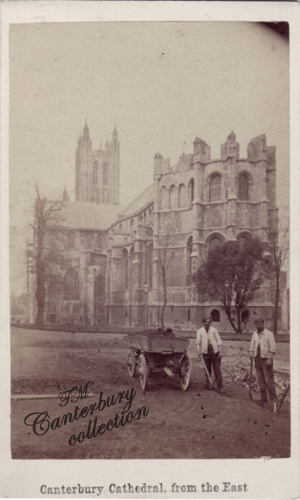
"Canterbury Cathedral from the East" Trimnell's Fancy Repository, 9, Mercery Lane, Canterbury, from my collection
Postcard of a Church Parade at Canterbury Cathedral
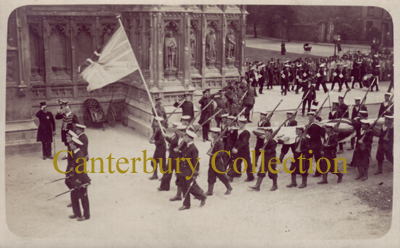
The flag of HMS Kent arriving at Canterbury Cathedral, a postcard in my collection
__
The Archbishop and General Young. Posted Sept 23 1914, from Canterbury. J. G. Charlton, Photographer, Canterbury - From my collection. What was the event? (I'm assuming possible send off of troops for the war?)
The links below are clickable for a larger view of the subject
|
South-West Porch of the Cathedral |
|||
|
Dean Johnson |
|||
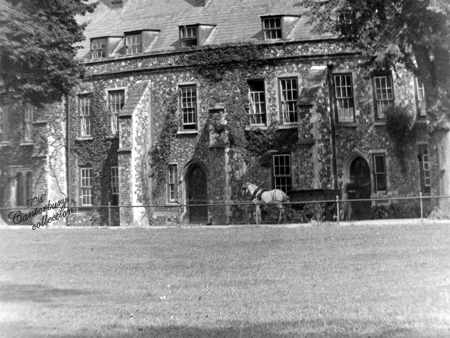
"The organ in Canterbury Cathedral was originally built for the Handel commemoration, held in Westminster Abbey, in 1791, and was afterwards purchased for Canterbury Cathedral. It is situated out of sight in the triforium, over the south aisle of the choir, and the organist plays it setting in the choir." Builder
February 25, 1893 (WTHBH) The Excavations in the Cathedral Crypt. - A report has been current in Canterbury this week to the effect that during the excavations in the Crypt of the Cathedral, now in progress, a Cardinal's tomb has been discovered. As a matter of fact, however, there has been no new discovery in the Crypt. The ciruclation of the report undoubtedly arose from the fact that the workmen, who are removing the accumulated rubbish, have just come to the part where Cardinal Morton's grave is situated, but both the grave and the ledger-stone covering it have always been known and recognised from the day of the Cardinal's burial.
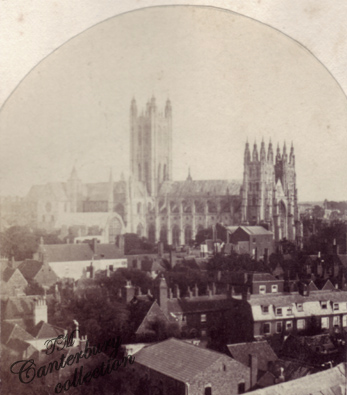
A photograph of the Cathedral from my collection
Glass Lantern Slides in my collection
Canterbury Cathedral Nave Looking East - G.W.W. (George Washington Wilson 1823-1893)
Canterbury Cathedral from the South West
Canterbury Cathedral - Williams, Brown & Earle, 918 Chestnut St. Philadelphia
Canterbury Cathedral Crypt - G.W.W.
The Baptistry, Canterbury Cathedral
Pilgrim's Steps, Becket's Shrine - Newton & Co. (c. 1880 - 1920)
Bell Harry Tower from Green Court - Newton & Co.
Tomb of Henry IV and Joan of Navarone
The Martyrdom, Becket's Shrine - Newton & Co.
Canterbury Cathedral, Lady's Chapel - Newton & Co.
Statue of Queen Bertha
The Black Prince's Tomb
The Walloon or French Church in the Crypt
The Choir looking West
Canterbury Cathedral the Crypt
A very detailed carved chest (type of dresser possibly) - no information written on the slide
Admiral of the Fleet Sir George Rooke, from the Beaney Museum courtesy of Craig Bowen
He is buried in St. Paul's Church, Canterbury
The intrepid Sir George Rooke is commemorated by a good bust, having a large flowing peruke, over a marble tablet garnished with a naval trophy, and bearing a well-written epitaph. These are supported on a pedestal, and grace on the sides by fluted Corinthian pilasters, supporting an entablature, from which depends a curtain, and on which rest three ornamented shields, that in the centre adorned with flowers.
----
A monument to Sir George Rooke, who was descended of an ancient and honourable family, seated at Monks Horton, in Kent. And of the same family very probably was George Rookes, a person in the service of King James I, who was sent by him upon some special affairs in Sicily, in the year 1604. Sir William, this brave Admiral's father, was Sheriff of Kent and Mayor of Canterbury in 1684.
"Sacred to the memory of Sir George Rooke, knt. (son of Sir William Rooke, knt.) Vice-Admiral of England. O how much History is in that Name! And how little is this inscription able to relate it! The french flying from the fight, in the Year 1692, he, in an open boat, amidst the showers of great and small shot, (in the prescens of so many FRENCH, a deed scarce credible by Posterity!) having first prepared the Fire-ships, burnt thirteen Ships of War near La Hogue. Afterwards, the difference between the SWEDES and DANES being happily and justly composed by his advice, he left the North in peace, and returned Southward; where a whole Fleet of the Enemies convoying Ships being either burnt or taken at VIGO, he safely brought to ENGLAND the Galleons, ships of immense burden, loaden with Treasure, and with the utmost integrity lodged the rich spoils in the public Treasury. He took GIBRALTAR with the Fleet, in fewer Hours, than a regular Army afterwards in Vain besiged it Months. And with the same Career of Success, his Navy being as much inferior in strength as it was superior in Coduct and Courage, he put to flight the whole FRENCH fleet; which, tho' well provided, dared not again to hazard a battle." *the memorial is located in the Warriors Chapel and is written in LATIN
Stephen Langton tomb, Canterbury Cathedral (Warriors chapel), a glass slide from my collection
Archbishop of Canterbury between 1207 and 1228
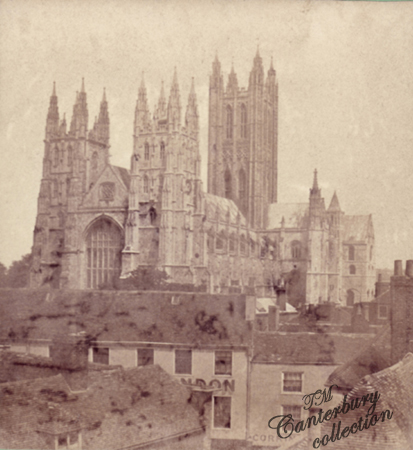
An old stereoview from my collection showing Palace Street possibly and the Cathedral in the background 1860/70
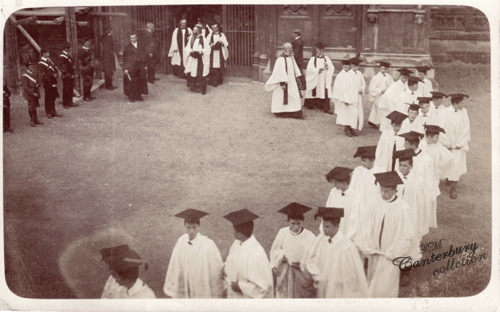
Postcard mailed to Miss Orme, 50 Castle Road, Newport, Isle of Wight from Luturihe, Worthing. These Photos were taken on 5th of July when about 200 bishops came down from all parts of the world, there were two black ones. Worthing is awfully full now. It is very hot here. Harold goes to France on Friday. Love Peter - Posted from Worthing 7:15 pm August 3, 1908
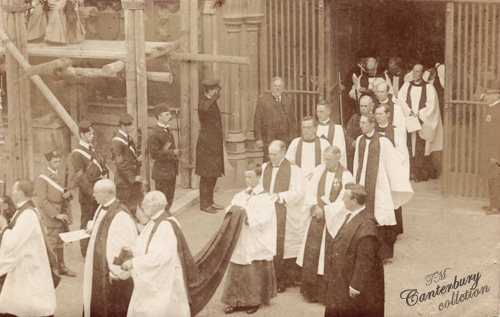
Postcard mailed to Miss Orme, 50 Castle Road, Newport, Isle of Wight from Lutwiche Longellow Road, Worthing. Dear M. I got back alright on Friday evening and left C. alright. Hope you are getting on well & looking forward to seeing you, this is a P.C. of the Bishops coming out of the W. end of the Cath. after the reception by Arch B. in connection? of Lambeth Conference. The Dean & Arch. B. are marked with x. Love Peter - Posted from Worthing 7:15 pm August 3, 1908
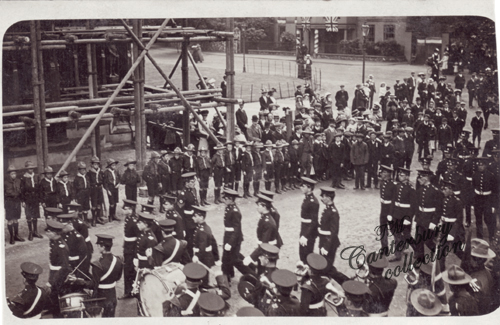
Postcard of the Boy Scouts at Canterbury Cathedral
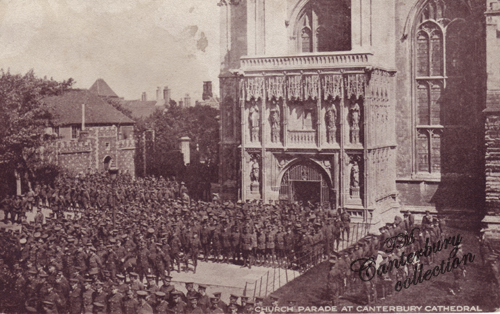
Postcard of a Church Parade at Canterbury Cathedral
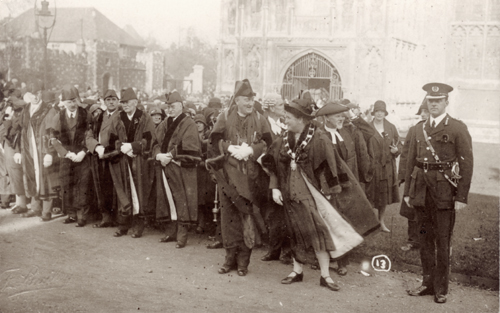
"The Cathedral 1930 Armstice Service "
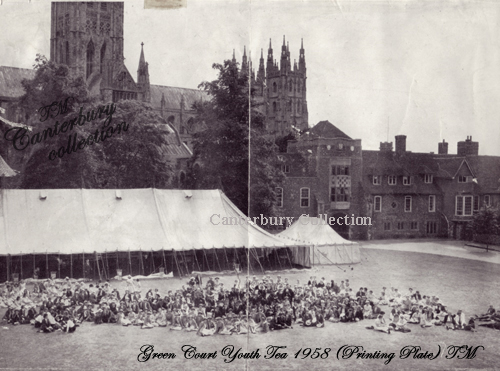
A Printing Plate in my collection of the Green Court Youth Tea 1958
November, Died at his house, in the Cathedral precinct, Canterbury, the Rev. Joseph Price, B.D. vicar of Littlebourn. UM 1806
On the 13th of July, 1818, Dr. Broughton, Bishop of Sydney, was married in Canterbury Cathedral to Sarah Francis, eldest daughter of the Rev. John Francis, Rector of St. Mildred's in that city, Vicar of Willesborough, and one of the six preachers of the Cathedral. GM 1853 (re his obit)
July 1896 - Choral evensong in the Welsh language was celebrated for the first time in Canterbury Cathedral on the 13th.
July 1896 - The Golden Wedding of Canon and Mrs. Rawlinson was celebrated in the Precincts of Christ Church Canterbury, on the 6th.
July 1896 - On the 7th the annual pilgrimage of the members of the Roman Catholic "Guild of our Lady of Ransom" to the spot in Canterbury Cathedral where Becket was murdered, to pray for the conversion of England, took place. The pilgrims numbered over 700 persons.
1896 - This month the Dean's fund for the Restoration of Canterbury Cathedral reached £10,000, half the amount required.
1896 - On the 23rd inst. the annual festival and conference of the Canterbury Diocesan Sunday School Teachers' Association was held at the Cathedral, when about 1,200 teachers assembled from all parts of the country. The conference was under the presidency of the Dean, and was addressed by Mr. J. R. Diggle, Mayor of Tenterden, a prominent member of the London School Board.
"The tomb of St. Thomas the martyr, archbishop of Canterbury, exceeds all belief. Notwithstanding its great size, it is wholly covered with plates of pure gold; yet the gold is scarcely seen because it is overed with various precious stones and sapphires, balasses, diamonds, rubies, and emeralds; and wherever the eye turns something more beautiful than the rest is observed. Nor, in addition to these natural beauties, is the skill of art wanting, for in the midst of the gold are the most beautiful sculptured gems both small and large, as well such as are in relief, as agates, onyxes, cornelians, and cameos; and some cameos are os such size that I am afraid to name it; but everything is far surpassed by a ruby, not larger than a thumb-nail, which is fixed at the right of the altar. The church is somewhat dark, and particularly in the spot where the shrine is placed, and when we went to see it the sun was near setting, and the weather was cloudy; nevertheless I saw that ruby as if I had it in my hand. They say it was given by a king of France." Though here called a ruby it seems to have been a diamond; see hereafter p. 224
*Among the offerings of king Louis on this occasion, though not specified by Gervase, is supposed to have been the great glory of the shrine (already mentioned in pp. 167, 212) "that renowned precious stone that was called the Regall of France, which Henry VIII. put into a ring,* which he wore on his thumb." (Stowe, Chronicle, p. 155)
In 1220 Becket's body was taken up, in the presence of king Henry the Third and a great concourse of the nobility, and deposited in the shrine erected in the upper chapel, at the expense of cardinal Langton, then archbishop. From that time forward the feast of his Translation was yearly kept on the 7th of July. Every fifty years there was a jubilee, which took place in the years 1270, 1320, 1370, 1420, 1470, and 1520."
Marriage, October 9th, 1820, at the Cathedral church of Canterbury, James Beckford Wildman, esq. M. P. of Chillham castle to Mary Ann Lushington, daughter of S.R. Lushington, esq. M.P. for that city, and grand-daughter of the right hon. Lord Harris. AR
"Marriage at Canterbury Cathedral, Thomas Hyde Page, esq. of the corps of engineers to Miss Woodward of that city. (Knighted on the 22nd by his Majesty)" GM 1783
--------------------------
Died in the Precincts, Canterbury, universally respected, aged 77, Mr. Samuel Porter, organist of Canterbury Cathedral from 1757 till 1804, when he resigned. He received his musical education under that great master and composer, Dr. Greene, from whose instructions he became a great proficient in the science of music (as his compositions fully demonstrate), and arrived at a high pitch of eminence as a teacher, and more particularly as a player of church music. He was a kind parent, a sincere friend, and a man of the strictest integrity. 1810 - buried in the cloisters of Canterbury Cathedral
Died, August, at Canterbury, Mr. Mineard, formerly organist in that Cathedral. UM1806
April 26, 1839, Married at Canterbury Cathedral, by his Grace the Archbishop, Major Hutchinson, 20th regt. eldest son of Lieut. General Sir W. Hutchinson, K.C.H. to Mary, daughter of the Rev. John Russell, D.D. Preb. of Canterbury, and Rector of St. Botolph's, Bishopsgate.
March 1, 1875 - We should have more pleasure in chronicling the fact of the title Mus. Doc. having been bestowed upon Mr. W. H. Longhurst, organist of Canterbury Cathedral, were we not constrained to add that it has been through the patronage (if we may so term it) of the Archbishop of Canterbury, who has the power, as our readers are probably aware, of granting this degree to any person who sufficiently earns his good opinion. That such an absurd privilege should exist in the present day is scarcely perhaps so extraordinary as that an Archbishop should be found to exercise it, and a musician to avail himself of it. Surely an artist of proved ability like the organist of Canterbury Cathedral would gain more real honour by refusing than accepting a title at the hands of an individual which he knows can only be legitimately granted by one of the Universities. The Musical Times
Organist - Sept 15, 1894 - Dr. W. H. Longhurst
Organist - 1900's Harry C. Perrin, Canterbury Cathedral Organist (Music)
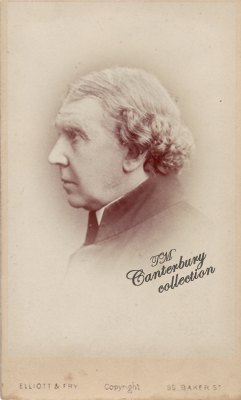
Archbishop Tate
TP April 5, 1924 - At the morning service at the Cathedral on Saturday the new Archdeacon of Canterbury (Ven. E. H. Hardcastle) was presented by the Vice-Dean (Dr. Bickersteth) to Dean (Dr. G. K. A. Bell), who installed him into his stall on the south side. The Dean of Canterbury (Dr. Bell) gave the religious address at the British Broadcasting Company's London studio on Sunday night. Canterbury listeners in heard it distinctly, as clearly and loudly as he was heard in Canterbury Cathedral on the previous Sunday morning.

